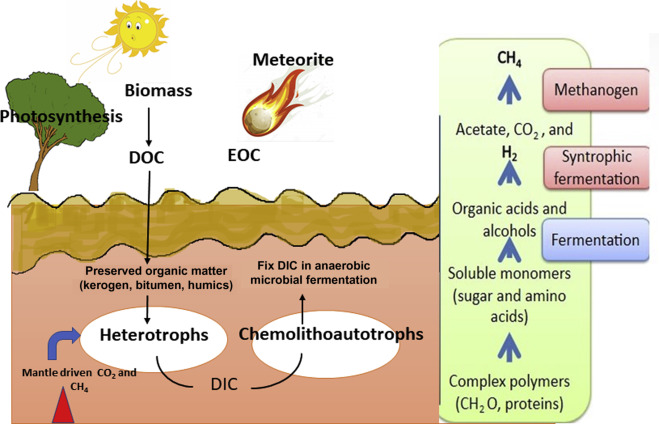Chemosynthesis Study Guide
Chemosynthesis
Chemosynthesis is a term coined by Wilhelm Pfeffer in 1897 to explain how plants and some organisms produce food in the absence of sunlight and oxygen. Instead of these raw materials, chemosynthetic organisms use inorganic compounds to produce glucose, giving them energy.
What is Chemosynthesis?
Chemosynthesis is a process involving converting one or more carbon molecules and nutrients into organic matter using oxidation. Organisms that use chemosynthesis need inorganic molecules instead of sunlight to produce food.

Chemosynthetic Bacteria
Chemosynthetic bacteria are organisms that use inorganic molecules as an energy source to produce food. There are two types of this bacteria: chemoautotrophs and chemoheterotrophs.
-
Chemoautotrophs are organisms that utilize chemical reactions to synthesize compounds from carbon dioxide. Some of the commonly used energy sources by these organisms are compounds of sulfur, ammonia, iron, or manganese.
-
On the other hand, chemoheterotrophs cannot form organic compounds, and thus they use inorganic energy sources (sulfur, etc.) or organic sources (carbohydrates, protein, etc.) to produce food for themselves.
Examples of Chemosynthesis
Bacteria, archaea, and several other types of organisms rely on chemosynthesis. Venenivibrio stagnispumantis, Beggiatoa, T.novellus, etc., are some examples of chemosynthetic bacteria.
The giant tube worms with bacteria found in large numbers near the deep hydrothermal holes or ducts are a good example of a chemosynthetic organism. They generate sugars and amino acids from carbon dioxide with hydrogen sulfide as the energy source. This type of chemosynthesis produces carbohydrates and is also known as chemical synthesis.
Examples of animals that use chemosynthesis include snails, scale worms, and limpets.

Chemosynthesis Equation
The chemical equation for chemosynthesis is as follows:
18H2S + 6CO2 + 3O2 → C6H12O6 (carbohydrate) + 12H2O + 18S
Reactants may vary based on the organism performing chemosynthesis. The process of chemosynthesis involves the conversion of inorganic elements (like the ones above) which contain molecules of methane and carbon dioxide. While this conversion occurs, there is a significant loss of electrons in these compounds.
Difference Between Photosynthesis and Chemosynthesis
Although photosynthesis and chemosynthesis are both processes that help organisms produce their food, there are certain differences between them.
-
Photosynthesis is performed mostly in sunlight, whereas chemosynthesis can be performed in the dark using chemical energy.
-
Photosynthesis occurs in plants and some bacteria and always involves the conversion of carbon dioxide and water into sugars and oxygen via solar energy.
-
Chemosynthesis occurs in bacteria and several other organisms and always involves the use chemical reactions between inorganic compounds to make sugars. Unlike photosynthetic organisms however, these chemical pathways differ between different types of organisms.
-
Since there is a difference in both of their workings, their equations will differ also.
-
The formula for the photosynthesis equation is:
6CO2 + 6H2O → C6H12O6 + 6O2
- The formula for chemosynthesis equation is:
CO2 + O2 + 4H2S → CH2O + 4S + 3H2O
✅ Conclusion
-
Chemosynthesis is a process by which food is produced without oxygen and sunlight in places such as dark caves and methane clathrates.
-
In this process, the only raw material that chemosynthetic organisms and plants want is inorganic elements, such as methane and sulfur.
-
Autotrophs that use chemosynthesis to produce food underwater are known as chemosynthetic autotrophs. Several bacteria such as algae and several oceanic animals use this process for food production.
-
Chemoheterotrophs cannot form organic compounds, and thus must use inorganic or organic energy sources to produce food for themselves.
-
The chemical equation for chemosynthesis is 18H2S + 6CO2 + 3O2 → C6H12O6 (carbohydrate) + 12H2O + 18S.
FAQs
1. What are some examples of chemosynthesis?
An iron-oxidizing chemosynthetic bacteria such as Beggiatoa, T. Novellus, and ferrooxidans. Bacterias like methanogens produce methane gas.
2. What is chemosynthesis, and why is it important?
Chemosynthesis is the process by which organisms use the energy produced from inorganic chemical reactions to make food. Chemosynthesis is essential for the formation of sugar in bacteria’s bodies.
3. How do chemosynthetic bacteria make food?
Chemosynthesis bacteria oxidize sulfur present in the atmosphere to produce foods. In simple words, bacteria convert inorganic non-living matter into food.
4. What is the main purpose of chemosynthesis?
Organisms that use chemosynthesis live in isolated caves, methane clathrates, and dark and cold seeps. This process makes it easier for these organisms to produce food even in the dark, where oxygen is absent.
5. Which plants use chemosynthesis?
Autotrophs are the type of plants that employ chemosynthesis in food production. Algae is one such plant that lives in the darkest of places and produces food without oxygen.
6. What is the main product of chemosynthesis?
The main product of chemosynthesis is glucose utilized by plants and organisms as food. This is accompanied by water, which has carbon dioxide dissolved in it. One by-product that is produced in this process is sulfur.
7. Which bacteria is associated with chemosynthesis?
Some chemosynthetic bacteria are Bacillus, Halobacterium, Clostridium, and Vibrio.
We hope you enjoyed studying this lesson and learned something cool about Chemosynthesis! Join our Discord community to get any questions you may have answered and to engage with other students just like you! Don’t forget to download our App to experience our fun, VR classrooms – we promise, it makes studying much more fun! 😎
]]>